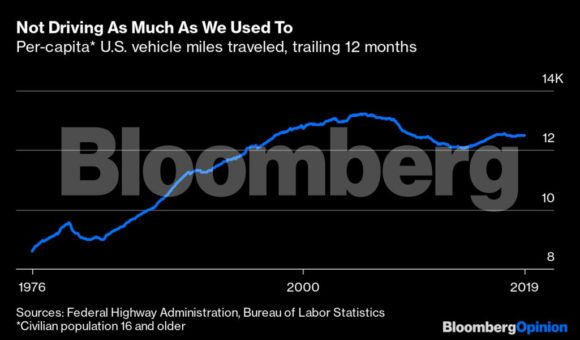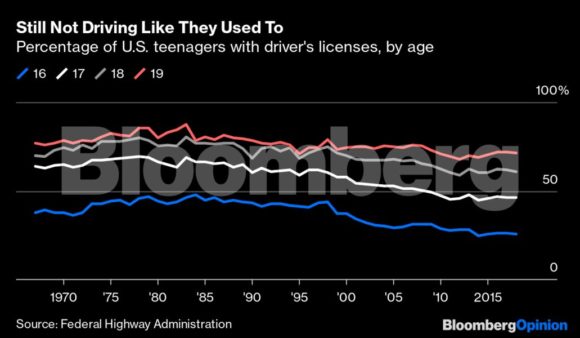The much-discussed collapse in teenage driving in the U.S. seems to have ended a few years ago. But the less-discussed recovery, which I wrote about last year, seems to be over, too. Newly released data from the Federal Highway Administration shows the percentage of American teenagers with licenses to have more or less plateaued at levels much lower than those of a few decades ago. In 1984, 47.8% of 16-year-olds in this country could legally drive. In 2018, only 25.6% could.
The simplest explanation for this trend, and especially the fact that it is more pronounced among 16-year-olds than 19-year-olds, is that it’s a lot harder for a 16-year-old to get a license and go for a drive than it used to be. Since the mid-1990s, states have imposed a panoply of new restrictions on when and with whom those under 18 can drive, under the (seemingly correct) assumption that this would reduce accidents and driving deaths. Many states have also cut back sharply on funding for driver’s education.
More generally, young Americans have been going through the rites of adulthood — finishing school, getting a job, moving out on one’s own, getting married, having kids — at later and later ages. Why should getting a driver’s license be any different?
Still, there are ample indications that the acquisition of driver’s licenses isn’t only being delayed. Licensed drivers’ share of the population has continued to rise as the population ages, but according to transportation researcher Michael Sivak — who has done more than anyone to raise awareness of this shift — members of every age cohort under 45 were less likely to have a license in 2018 than in 1983. Among those ages 25 to 29, 85.7% had licenses in 2018, down from 95.6% in 1983. Also, Americans in their 30s and 40s used to be much more likely to have licenses than those in their 60s. Now they’re less likely to have them.
Cars and car ownership aren’t going away. This isn’t becoming a nation of Uber takers and scooterers, at least not yet, and while transit ridership is higher than it was in the 1960s through 1990s, it has fallen since 2014 and remains very much a minority pursuit. But per-capita vehicle miles traveled in the U.S. are well below the levels of the mid-2000s, and have plateaued recently after bouncing back a bit from 2014 to 2017.

In other words, we seem to have passed peak automobile in the U.S., and teenagers have noticed.
Topics Personal Auto
Was this article valuable?
Here are more articles you may enjoy.



 Adjusters Launch ‘CarFax for Insurance Claims’ to Vet Carriers’ Damage Estimates
Adjusters Launch ‘CarFax for Insurance Claims’ to Vet Carriers’ Damage Estimates  Door of Swiss Bar Where 40 Died in Fire Was Locked, Says RTS
Door of Swiss Bar Where 40 Died in Fire Was Locked, Says RTS  Alliant Latest to Sue Howden US Over Alleged ‘Smash-and-Grab’ Poaching
Alliant Latest to Sue Howden US Over Alleged ‘Smash-and-Grab’ Poaching  MAPFRE Accuses AAA of Violating Long-Time Exclusive Marketing Agreement
MAPFRE Accuses AAA of Violating Long-Time Exclusive Marketing Agreement 

